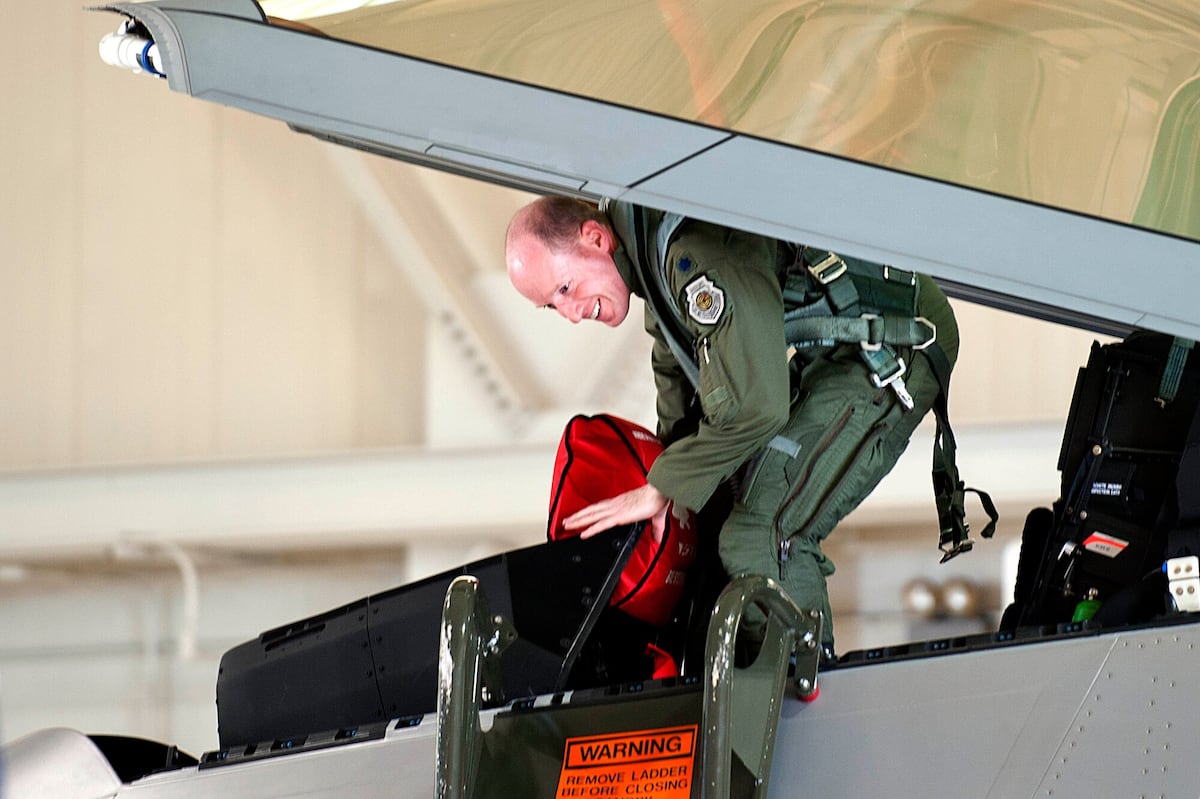New: President Trump has ordered the Pentagon “to begin using military force against certain Latin American drug cartels” both “at sea and on foreign soil,” the New York Times reported Friday, citing officials familiar with the directive.
Notable: “[D]irecting the military to crack down on the illicit trade also raises legal issues, including whether it would count as ‘murder’ if U.S. forces acting outside of a congressionally authorized armed conflict were to kill civilians—even criminal suspects—who pose no imminent threat,” four reporters for the Times write.
Background: The idea of using the U.S. military against drug cartels “took root among Republicans and became a talking point in the 2024 election cycle. Mr. Trump vowed on the campaign trail to deploy Special Operations troops and naval forces to, as he put it, declare war on the cartels.”
The Caine effect? “One constitutional legal expert with deep expertise in national security and classified work told Defense One in February that Trump’s selection of [Joint Chief Chairman Air Force Gen. Dan Caine, with experience at Joint Special Operations Command], coupled with the removal of top service lawyers who would likely object to Trump’s personal interpretation of presidential war powers, means ‘if the Trump White House is looking to wage a covert war in Mexico, they certainly could.’”
Also: Trump’s attorney general announced a new $50 million reward for information leading to the arrest of Venezuelan President Nicolás Maduro under the State Department’s Narcotics Rewards Program on Thursday. “Maduro has been a leader of Cartel de los Soles, which is responsible for trafficking drugs into the United States,” the State Department said in a separate statement Thursday.
Additional reading:
The U.S. Air Force has denied early retirement to its transgender service members with 15 to 18 years of military service, booting them from the Defense Department with no retirement benefits, Reuters reported Thursday after viewing a copy of the service’s memo.
The deciding official is Brian Scarlett, who is performing the duties of the assistant Air Force secretary for manpower and reserve affairs. “After careful consideration of the individual applications, I am disapproving all Temporary Early Retirement Authority (TERA) exception to policy requests in Tabs 1 and 2 for members with 15-18 years of service,” he wrote in the August 4 directive.
According to advocates, “Multiple service members had already been approved for early retirement, but those approvals were rescinded,” Reuters reports. The Associated Press reports “About a dozen service members had been ‘prematurely notified’ that they would be able to retire before that decision was reversed.” A lawyer who represents LGBTQ+ clients told AP she expects the rest of the Defense Department to follow suit.
Welcome to this Friday edition of The D Brief, a newsletter dedicated to developments affecting the future of U.S. national security, brought to you by Ben Watson with Bradley Peniston. Share your tips and feedback here. And if you’re not already subscribed, you can do that here. On this day in 2022, the FBI executed a search warrant at former president Donald Trump’s residence in Mar-a-Lago and discovered troves of classified documents violating the Espionage Act. But similar to his indictment related to the insurrection at the U.S. Capitol, Trump was let off the hook thanks to procedural delays in court leading up to the 2024 election.
Industry
After years of delays, the United Launch Alliance is set to launch its first military mission on the new heavy-lift Vulcan rocket next week, Defense One’s Audrey Decker reported Thursday. The mission, USSF-106, will send into geostationary-Earth orbit the Navigation Technology Satellite-3, or NTS-3, an experimental navigation satellite built by L3Harris and funded by the Air Force Research Laboratory.
Rewind: The company, which is moving its heavy-lift work to the Vulcan rocket, was supposed to launch four Space Force missions last year. That number was pared to two and pushed to 2025, in part due to delays with certifying the rocket after its second flight in October. During that flight, material broke off one of the solid rocket boosters. Vulcan achieved certification in March, joining SpaceX as a provider for the Space Force’s National Security Space Launch program.
ULA CEO Tory Bruno: The cause of the booster problem has been addressed and corrective actions are in place, but it did set the company back. The company now expects to fly nine times this year with a combination of new Vulcan and remaining Atlas rockets, Bruno told reporters Thursday. That’s down from the company’s target of 20 launches. Continue reading, here.
Lockheed has a new planning-and-ideas hub for the Indo-PACOM region. The world’s largest defense contractor, Maryland-based Lockheed Martin, recently opened an office for collaborative planning with allied nations in Honolulu, Hawaii, just a few miles from the U.S. military’s Indo-Pacific Command headquarters near Pearl Harbor.
Lockheed calls the facility a Digital Engagement Center—the 12th of its kind since the firm launched the DEC program four years ago under CEO James Taiclet. Ten others are stateside: four across Virginia, one in New Jersey, another in Alabama, and others in Texas, New York, Colorado, and Florida. There’s also a more NATO-focused DEC that opened in Brussels, Belgium this past December. Two more are planned for Saudi Arabia and Japan.
The thinking behind these DECs: “If I want the ability to introduce new technical ideas and capabilities, and I want to do it from a joint and international perspective,” Michael Williamson, Lockheed’s senior vice president of Strategy and Business Development, told Defense One. With that as the goal, “You really have to kind of change your processes and the approach that you take for gathering that information and sharing that information.”
The facilities are networked for all classification levels, from unclassified to TS/SCI/SAP. And that can save a considerable amount of time, Williamson said. “These are real scenarios where, you know, the Japanese defense forces, as an example, they’ve made decisions to expand their capabilities. But how do they make choices in terms of what to prioritize and in what kind of quantities are necessary to achieve their capability objectives? What we allow them to do through the use of these facilities, is be able to put in different—whether it’s integrated air- and missile defense, whether it’s long range precision fires, whether it’s ISR—they can put in different mixes of capabilities, and then using our facility, that allows us to do experimentation and iterate on it.”
With these 12 facilities, Lockheed and its clients can conduct detailed planning sessions “in a virtual environment without having to spend months, years and lots of money moving people back and forth between, you know, name a country, and back to our facility in in Virginia to run those experiments, because we are connected in real time, and have the opportunity to connect all of them through this Lockheed network, and we can do it securely,” said Williamson.
“We thought it was important to be able to not only do multi-domain [operational planning], but multi-nation,” he said. This new facility in Hawaii opens that up for the U.S. and Lockheed’s clients in the Pacific region. “If you’re a senior leader in the Pacific or a senior leader in other parts of the world, you know that [a potential regional conflict is] going to be a joint fight, and you also know that you’re going to go into any fight with coalition and allied partners,” Williamson said. “Now if you put a workstation in Japan and Australia, I can literally have someone sitting in an F-35 simulator, as an example, in Hawaii, flying with someone who’s sitting in a simulator in Australia—or, for that matter, in Europe. And they can fly a mission together and walk through processes—not just the physical characteristics of the aircraft as an example, but the processes that they would use in executing a mission. And you don’t have to wait till next year to try out the next experiment. You can do that two hours later. That’s the value of having these multiple locations and the connectivity that we have.”
Another consideration: LMT’s DEC operations aren’t focused only on Lockheed products, Williamson said. “The reality is that all nations have things that they have invested in that they’re not going to throw away. And so we think, because of some of the technologies, some of the capabilities that we are aware of have been not necessarily created by Lockheed Martin, but by some of our competitors, we think that this gives us an opportunity to take the old, the stuff that already exists, and combine that with the new technologies in different ways that create a new effect.” Read or see more about the new facility in Honolulu via LMT’s Wednesday news release, here.
By the way: The world’s second-largest arms importer, India, has reportedly paused its plans to buy more American weapons in response to Trump’s tariffs, Reuters wrote Friday from New Delhi, citing Indian officials. The pause is believed to affect the sale of “Stryker combat vehicles made by General Dynamics Land Systems and Javelin anti-tank missiles developed by Raytheon and Lockheed Martin.”
Origin: “Trump on Aug. 6 imposed an additional 25% tariff on Indian goods as punishment for Delhi’s purchases of Russian oil, which he said meant the country was funding Russia’s invasion of Ukraine. That raised the total duty on Indian exports to 50%—among the highest of any U.S. trading partner,” Reuters writes.
The pause may not last long given Trump’s “history of rapidly reversing himself,” the wire service adds, while noting that Indian defense officials are officially denying any pause. More, here.
Additional reading:
Weekend reading
And lastly, an explosive #LongRead about the latest Israel vs. Iran war. Israeli intelligence agents secretly recruited Iranian dissidents to attack their country from within as part of Israel’s devastating attack on Iran in mid-June, ProPublica reported this week in an extraordinary inside account.
Excerpt: “The attack had been planned for more than a year by the Mossad, the Israeli intelligence service. Just nine months earlier, the spy agency had shocked the world with its technical prowess—executing a plot hatched in 2014 by its director at the time, Tamir Pardo, that crippled Hezbollah by detonating pagers booby-trapped with tiny but lethal amounts of explosives.” But “At 3 a.m. on June 13, S.T. and a foreign legion of roughly 70 commandos opened fire with drones and missiles on a carefully chosen list of anti-aircraft batteries and ballistic missile launchers. (His handlers in the Mossad would only tell us his initials.) The next day, another group of Iranians and others recruited from the region launched a second wave of attacks inside Iran.” Reporters Yossi Melman and Dan Raviv of ProPublica have much more, here.
Extra reading: “Satellite images show Israel building up forces for a possible ground invasion of Gaza, sources say,” NBC News reported Thursday.
Read the full article here








Leave a Reply